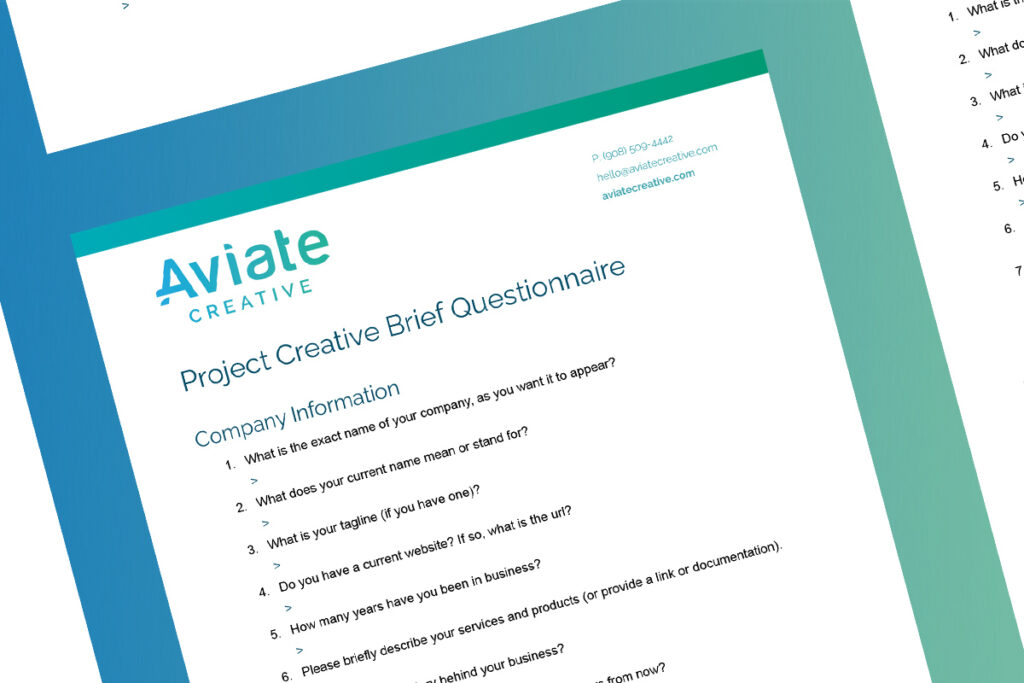When you think of a creative brief, most associate the term with graphic designers, advertising or PR firms or a creative manufacturing branding agency like Aviate. It is a document, sometimes succinct, oftentimes lengthy that asks a series of questions that a client then provides answers to before a project commences.
A rock solid creative brief should be all about providing the ground level deep dive details of a project; background, objective, company or product origin story, timelines, target audience, positioning, differentiators, brand identity and style guidelines, and perceived competition.
The gist of a creative brief should answer the question “Why are we embarking on this project or marketing/branding effort in the first place?”
If a definitive answer doesn’t materialize from the provided answers, that is reason to take a collective pause. Why? Because a company needs to establish if the effort is to:
- gain brand awareness
- launch a new product line
- convert on sales
- recruit employees
- promote an event
- a combination of goals
Roadmap For Getting to the Finish Line
Think of a creative brief as a roadmap to get everyone from a starting point to a desired destination. Creative briefs organically should point everyone in the same direction and touch on all the essential elements of any scope of work.
Creative briefs at their core are essential as any creative effort relies around what general expectations are. Aviate Creative issues a creative brief intake form, that has approximately 30 questions, before we step into any kind of discussion, kick off meeting or discovery.
Inherently the answers given in a creative brief trigger additional queries that stem from its review. Many times we unearth through creative briefs if a client doesn’t know what they don’t know OR if they want a project to do too many things.
This Forbes article offers up supportive rationale for why a creative brief, which some might view as a tedious part of the intake process, is a very valuable part of the overall client/agency project process.
As a manufacturing branding agency who works with clients in the industrial, technology and manufacturing sectors, Aviate’s use of creative briefs proves even more important to extract from company subject matter experts information, data and language that is relevant. We then hone our questions as we head into discovery meetings to ensure we query correctly to fulfill any demands we need to tackle things on our end.
The More Details Provided Ahead of Time the Better
A creative brief guides our entire manufacturing branding agency team from the outset and a fully vetted one shares vital details which mitigates rework in many instances.
A strong solid creative brief is far more than a checklist. It sets the tone and the way forward for each project or phase of a project. Ideally, it serves as a catalyst for the brainstorming process and acts as a hub of information for our team to return to and reference.
A well thought out creative brief is imperative no matter the scale of the project. From quick turnarounds to long drawn out projects, a solid creative brief is the one document all parties refer to throughout the life of the campaign or launch.
Knowledge is Power
By successfully tracing a distinct starting point (the information provided in a creative brief) and the desired end point (the vision), your team gains insight into the possible routes to get there.
This is particularly effective when there is a strong link between product/service, brand identity and positioning; a trio of factors that, when combined together, can help shine a light on the best path forward. Again, it’s about getting everyone on the same page, so as to get the best outcome for all parties involved.
Without a creative brief, you leave a lot of room for assumption and interpretation which nearly always leads to rework. And without one you may go through endless rounds of revisions and field frustrating emails or phone calls in addition to spending excess money and effort to get things right.
The Big Picture
Without fully understanding the who, why, what and when behind any project, a good strategy cannot be fully realized. Since a good creative brief benefits both agencies and the clients they serve, it is always beneficial to get the goods on the big picture prior to jumping into any initiative.




